Traditional German Spaetzle Recipe
This post may contain affiliate links. See my disclosure policy.
One of Germany’s most popular and beloved foods, here is a fool-proof and authentic German Spaetzle recipe, just the way my Mutti and Oma made it! Perfect texture and perfect flavor, these are just like you know and love them from the Swabia region of Southern Germany where they originated!
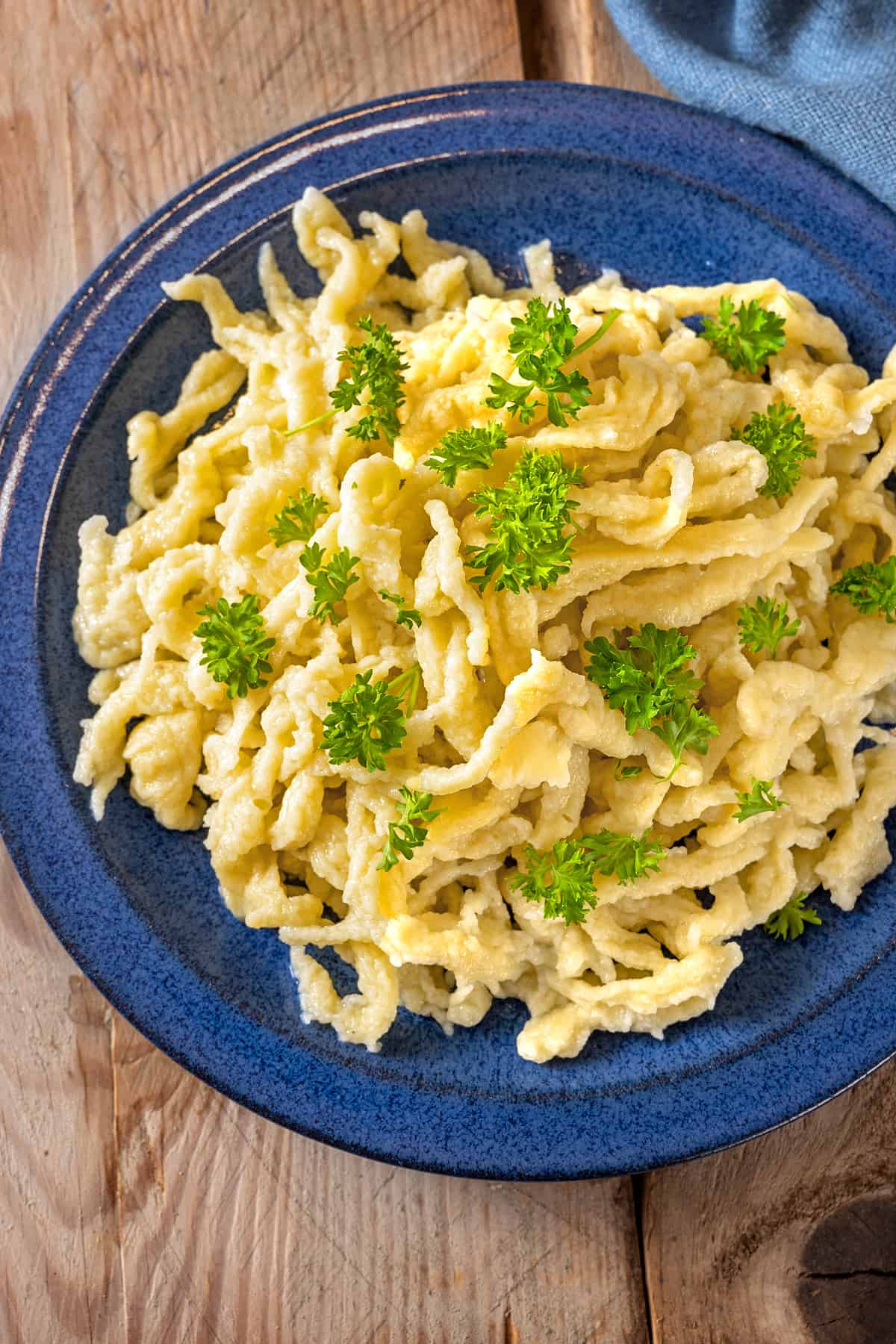
What is Spaetzle?
One of the most beloved foods in Germany that tourists go home talking about is Spaetzle, the famous German egg noodles from the Baden-Württemberg region of southwest Germany. This area is also known as Schwabenland, or Swabia. I grew up in Stuttgart, the capital of Baden-Württemberg, watching my Mom and Oma make Spätzle – I learned from the best!
Swabia is home to some of Germany’s best food (many, including myself, will argue it’s home to the best food in all of Germany). And that’s saying a lot because every region of Germany has amazing food. Swabia is known for its soups, sauces, meats, wursts, and salads, to name a few. It’s also home to some unique varieties of pasta including Spätzle, Schupfnudeln and Maultaschen.
Today we’re featuring Spätzle, a Swabian specialty that is also enjoyed in Austria and Switzerland. Spaetzle is a special type of egg noodle that is enjoyed with sauces and gravies as well as incorporated into a variety of different dishes. One example is Käsespätzle (a cheese spatzle casserole with crispy fried onions). Where did the name “Spätzle” originate? It comes from the German word Spatzen, meaning “little sparrows”, because that’s what they were thought to resemble when they were traditionally made by hand.
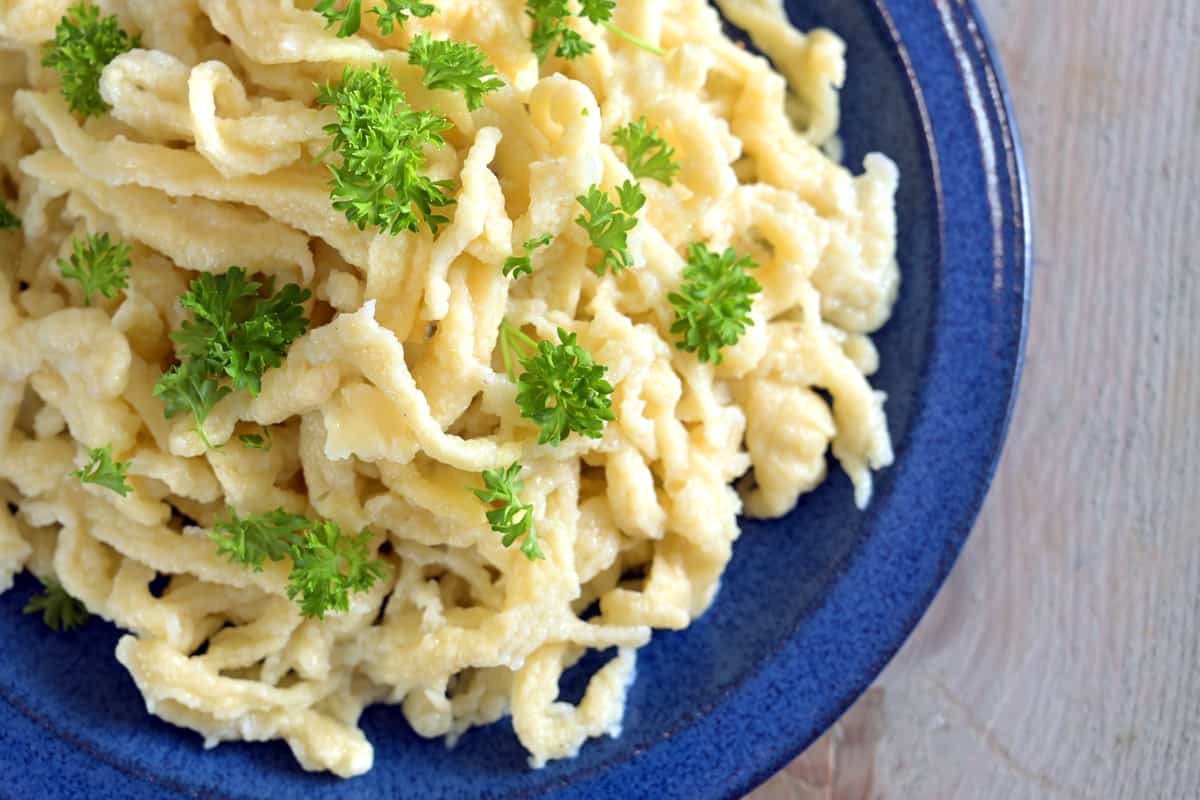
Spaetzle Ingredients
Spaetzle is a type of pasta and as such is made with a very few, simple ingredients that you’ll already have in your pantry. Here’s what you need:
- All-purpose flour: this creates a tender Spaetzle that still has a nice chewy texture.
- Eggs: these add richness and contribute to texture.
- Milk or water: You can use either but I prefer milk as it adds richness.
- Salt: enhances the flavor.
- Nutmeg: this is optional and is not traditional, though many German cooks today like to add it for flavor.
Spaetzle Recipe
Let’s get started!
This spaetzle recipe uses a stand mixer to knead/mix the dough. This is actually the first time I’ve made it that way. I’ve always done it by hand (you “knead” it by vigorously whipping it in a bowl with a spoon – over and over and over for around 20 minutes. It’s a lot of work!) I decided to to try it with a stand mixer instead and it turned every bit as good – and it sure saves a lot of muscle strain!
Add the flour and salt in the bowl of a stand mixer. Stir to combine. Crack four eggs into a bowl and whisk to combine. Make a well in the center of the flour and add the eggs. Add the milk or water and with the paddle attachment (I initially tried the dough hook and it didn’t work well), knead/mix the dough on the “2” setting for about 10 minutes to get a cohesive batter. Add more flour if the mixture is too runny, or more milk if it is too stiff.
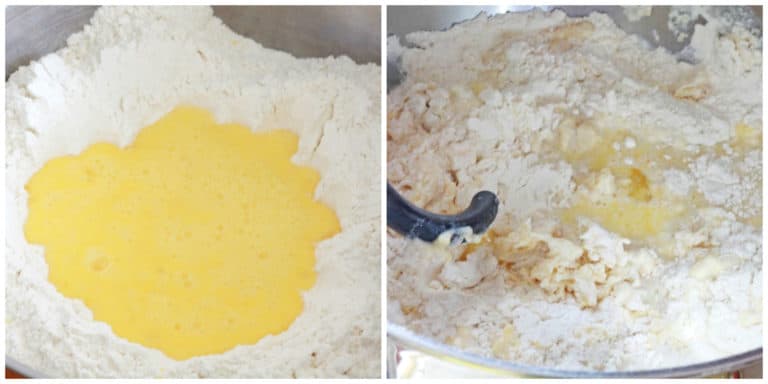
Pro Tip: How to Know When the Spätzle Batter is Ready
The batter is done when “bubbles” begin to form. After about 10 minutes of beating, use a wooden spoon and scoop and pull to stretch the batter; if bubbly holes appear, the dough is done. If not, continue “kneading” with the mixer for another minute or two, repeating the “test” process. See the bubble hole below?
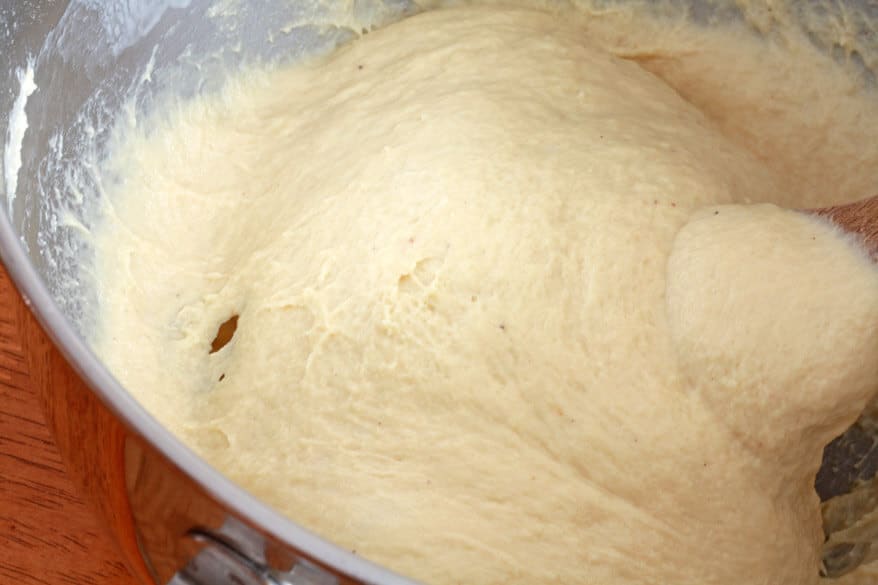
When those bubbly holes start appearing you know your batter is done.
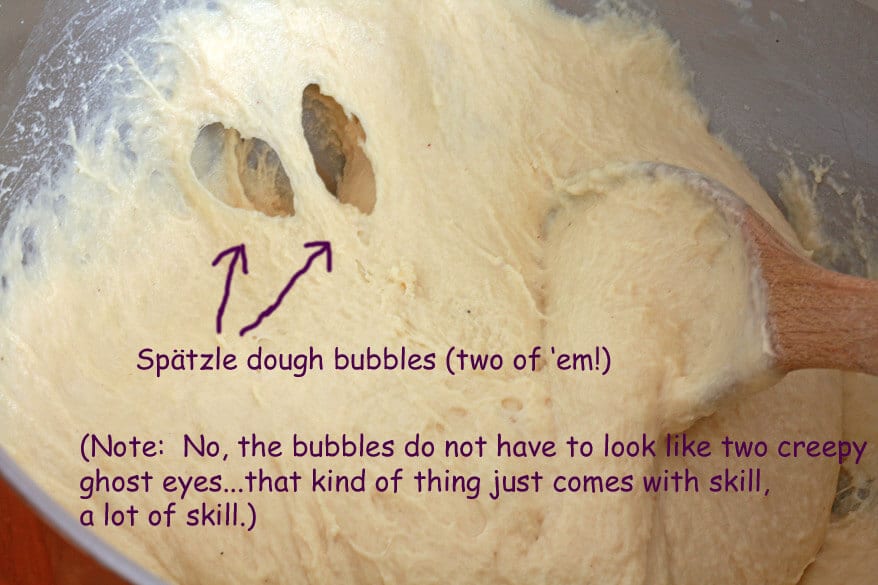
What Is the Best Spätzle Maker?
Now that the batter is read it’s time to make the Spätzle. And when it comes to the Spaetzle maker, there are a few options to choose from. Traditionally, Spätzle was made by hand using a Spätzlebrett, or Spaetzle board. You would rub a slab of dough out onto a wetted board and use a pastry cutter or long sharp knife to quickly cut off strands of the dough into simmering water. Swabian women of previous generations were highly skilled at this and could do it so fast it would make you dizzy to watch. Nowadays most Germans use a Spätzle maker (and even more just buy it ready made at the store. It’s the “convenience generation”).
Besides the traditional Spätzle board there are a few different kinds of Spätzle makers out there that you can find online:
- Spätzle Press (below left): That is my Spaetzle maker that I brought with me from Germany when I moved to the U.S. and it’s awesome. This kind is pricey but it will last a lifetime. It’s called the Original Kull Spätzle Maker and is made in Germany. It’s built like a tank and will become a family heirloom you can pass down for generations. Another brand that is much cheaper and is also made in Germany is this Westmark Spätzle Maker. These Spätzle presses can also be used as potato ricers.
- Spätzle Scraper (below right): Another option is the Küchenprofi Spätzle Lid & Scraper. I’ve used this one as well with good results and it’s much cheaper. It produces a shorter, stubbier spatzle noodle. Alternatively you can also use a metal steamer because it’s similarly constructed with large holes. You place some of the dough in the steamer over the simmering water and scrape the dough through the holes.
- Spätzle Plane: A third option is the Küchenprofi Spätzle Plane with Pusher, which is my least favorite as it can be a little clumsy, messy, and more difficult to work with but I know people who use it.
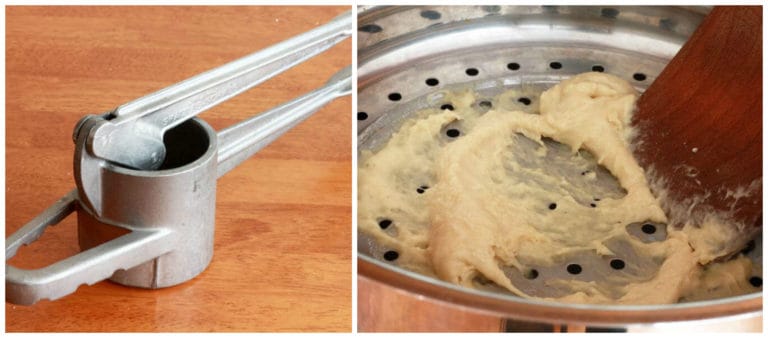
My personal favorite is the Spätzle press and that’s what I’m using in the pictures below. Place the Spaetzle maker over a pot of lightly salted simmering water and scoop some dough into it.
Press the Spätzle maker down to squeeze the Spätzle noodles out into the simmering water. Simmer the Spätzle for about 2-3 minutes or until they float to the top.

Using a slotted spoon, transfer the Spätzle to a colander and then immediately put them in a bowl of very cold water. This helps them firm up to the desired consistency.
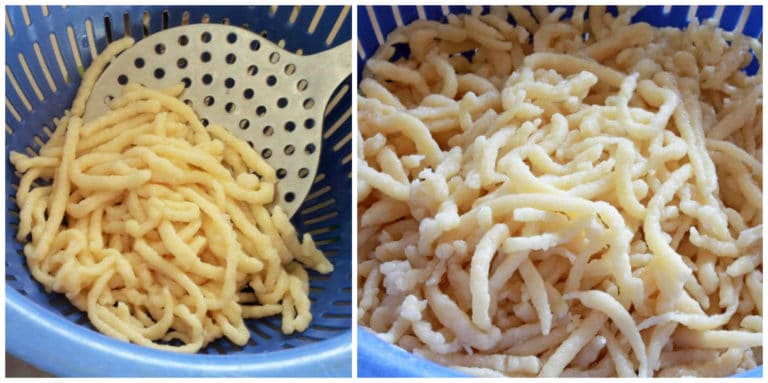
Drain the Spätzle again and toss with a little oil or melted butter to keep them from sticking.
Spätzle will keep in the fridge for at least a couple of days and then heated to serve. Melt some butter in a pan and toss the Spaetzle in it to warm through.
Storage & Freezing
Spaetzle can be made in advance, cooled, and stored in a covered container in the fridge where it will keep for 3-4 days. To reheat it you can microwave it in a microwave-safe container or, my favorite way, is to melt some butter in a large skillet, add the Spätzle and heat through. Spaetzle also freezes well for up 3 months: put it in a freezer-safe container and let it thaw overnight in the fridge. It can be reheated in the microwave in a covered container so that it doesn’t dry out, or you can melt some butter in a pan and toss the Spaetzle in it until warmed through.
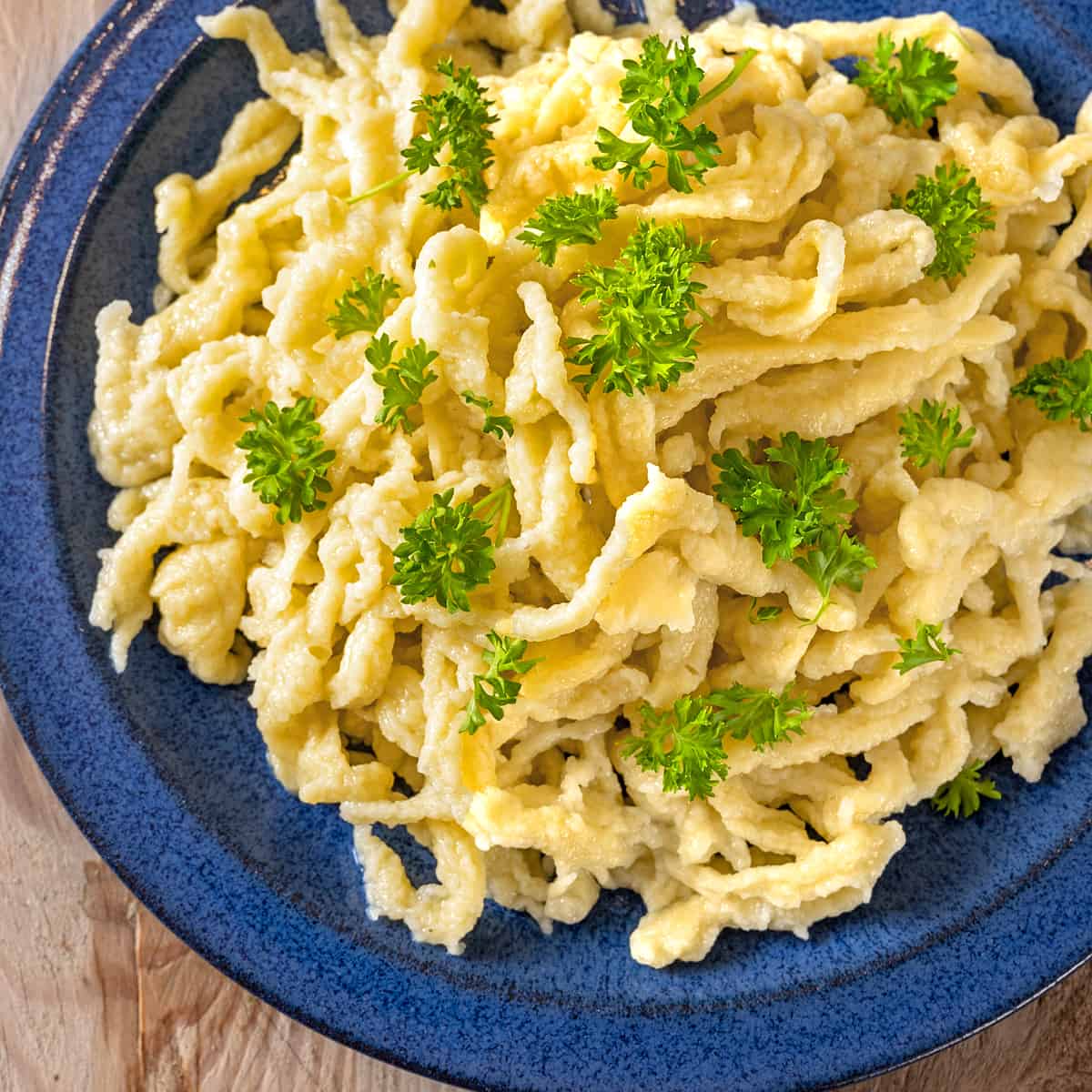
What to Serve with Spaetzle
Spaetzle is very versatile and can be served a variety of ways. Here are a ways to serve spaetzle:
- Buttered Spätzle: This is one of the simplest and most traditional ways to serve spaetzle. After boiling and draining the cooked spaetzle, toss them with melted butter and sprinkle with chopped parsley.
- German Cheese Spaetzle (Käsespätzle): Another Swabian classic and personal favorite, try my recipe for Käsespätzle (pictured below).
- With Sauces and Gravies: Spaetzle can be served with any sauce or gravy, like my favorite German Rahm Sauce, Onion Gravy, or Mushroom Gravy. Serve it with my classic German Goulash, Geschnetzeltes or Königsberger Klopse.
- With Meat Dishes: Spaetzle is the perfect choice to serve with any saucy meat dish like Jagerschnitzel, Rouladen, Sauerbraten, Pot Roast and Tri Tip Roast. It can also accompany your Schweinshaxe and Frikadellen.
- Pasta Salads: For a variation on traditional pasta salad, toss the spaetzle with fresh vegetables, herbs, a vinaigrette, and some diced cheese and ham.
- In Soups: In some regions, spaetzle is added to soups, much like dumplings. Drop small portions of spaetzle dough directly into simmering soup and let them cook until they float to the surface as in this Gaisburger Marsch and German Pea Soup.
Guten Appetit!
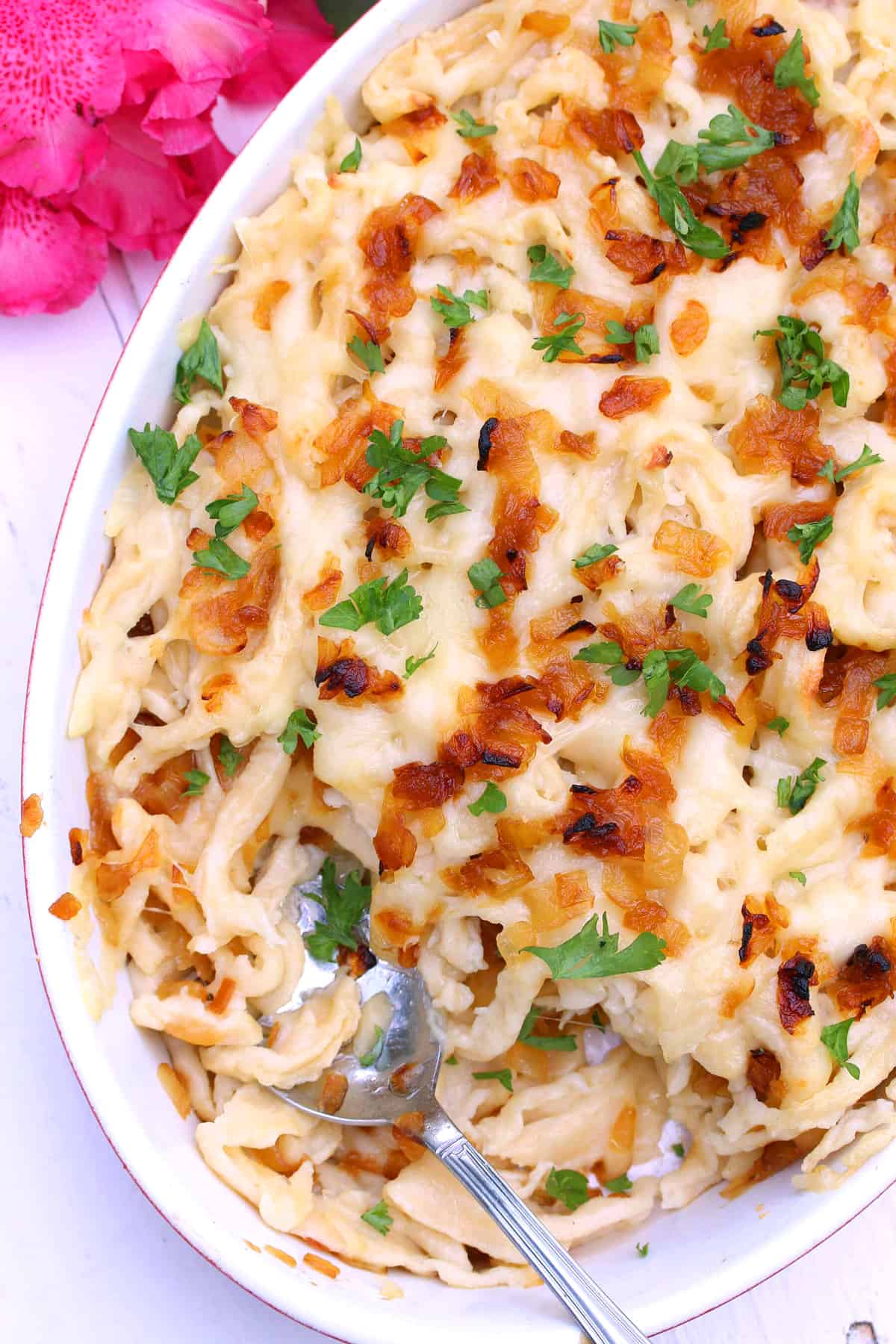
For more favorite traditional German dishes be sure to try my:
- Kaesespaetzle
- Rouladen
- Sauerbraten
- German Goulash
- Maultaschen
- Schnitzel
- Bread Dumplings
- German Potato Dumplings
- Zwiebelkuchen
- German Bread (Vollkornbrot)
- Bratwurst
- Currywurst
- German Potato Salad
- Rotkohl
Save This Recipe
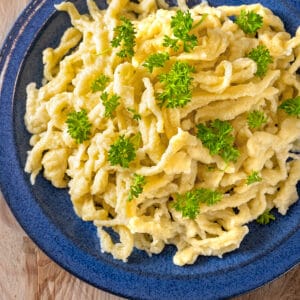
Traditional German Spaetzle Recipe
Equipment
Ingredients
- 2 cups all-purpose flour (you can also use whole wheat flour)
- 1 1/2 teaspoons salt
- 1/8 teaspoon freshly ground nutmeg , optional (not traditional but adds a nice flavor)
- 4 large eggs
- 1/2 cup milk or water + more as needed (milk produces a richer Spaetzle) (**add more flour if the dough is too runny, add more milk or water if it's too stiff)
- butter for serving
Instructions
- The Spätzle batter can be mixed by hand or by using a stand mixer which is much easier. Add the flour, salt and nutmeg (if using) to the bowl of a stand mixer. Stir to combine. Crack the eggs into a small bowl and whisk them. Make a well in the center of the flour mixture and pour the eggs in it. Add the milk (start with using slightly less and add more as needed). Attach a paddle attachment to the stand mixer and "knead" the dough for about 10 minutes or until bubbles appear (see pictured instructions for details). After 10 minutes or so of beating, use a wooden spoon to scoop and pull the dough. If bubbles/holes appear, the dough is done
- Bring at least 2 quarts of lightly salted water to a boil, then reduce to a simmer. Using a Spätzle maker of your choice (I use and prefer the Spätzle press), press the noodles into the simmering water and cook for about 2-3 minutes, or until the noodles float to the top. Use a slotted spoon to transfer the noodles to a colander to drain the hot water and then to large bowl of ice water (this firms them up for a better/chewier texture). After a minute or two transfer them to a colander to drain completely. Before serving, warm them through in a skillet with some melted butter.
- Make Ahead: The Spaetzle can be stored in the fridge for at least a couple of days and then reheated. Melt some butter in a large skillet and toss the Spätzle in it to heat through. Alternatively they can be microwaved in a covered dish.
Notes
Nutrition
Originally published on The Daring Gourmet on August 3, 2013



















Badische Spätzle or Schwaebische Spätzle and also Swiss Knoepfli. True Spaetzle need to be made from the “Spaetzlebrett with a Spaetzle Schaber.
An I am totally insensed by you referring to Spaetzle as noodles – there are NOT noodles.
Replacing the word Spaetzle with the word Noodles is an insult to All Schwaben, Badenzer and Swiss German.
I am sorry I have to write this – but I had to say it!
Gerhard, first of all, Spätzle IS a type of noodle. Secondly, if something so benign incenses and insults you, you need to get a grip on reality; take a look around you, there are FAR more important things in the world to be concerned about. So take a deep breath, get over it, and move on.
For real! Who gets incensed about noodles at a time like this!!
Gerhard!!! Born and raised in Germany. They are a type of noodle, hence the dough. Even my Oma(born1920) used a Reibe to make them, not just a cutting board. Get a life and let us enjoy
LMAO. Spaetzle are german noodles. And yes if using the word noodles offends someone.. Go get a life lol
Hello Gerhard, when it was introduced to me by a Hungarian he told me that it was a sort of dumpling but when sold ready-made in a shop, Spaetzle will most likely be found in the pasta section. Here it is classified as a pasta sort being just one of many different types of noodle: https ://g.co/kgs/kDNzFS
My culinary school textbook, “The Professional Chef” from the Culinary Institute of America, as well as my very German instructor chef both say spatzle is indeed a pasta.
Thank you for sharing your story and this recipe! It closely resembles the recipe my mother used as well, so I can here looking for a true recipe rather than eyeballing it. My mother was born in Stuttgart as well and grew up with her family’s restaurant servicing Spaetzle among other things. I grew up eating it and have now started trying to make it in my own.
I do have a question for you, I do not have a good press. I know you mentioned a couple very good ones, but I can’t afford those. Have you or anyone in the comments tried any of the cheaper models on Amazon to know if it comes out alright? Thank you!!
Hi Casey, that’s great that you’re carrying on the Spätzle-making tradition! I’ve tried all of the different Spätzle makers that I mention in my post. My least favorite is the the plane with pusher. The lid and scraper is the cheapest of gadgets and works well. And of course the cheapest option of all is also the most traditional: Cutting the Spätzle by hand using a cutting board that’s constantly wetted down with water, slapping some of the dough on it, spreading it thin, and then simultaneously chopping then scraping the dough in skinny strands into the water as you hold the board diagonally against the lip of the pot. It takes a lot of practice to be quick at it – I’m sure there are YouTube videos of the process. Happy cooking!
I am so glad I found your website! My father is from Schmiden ( our family has been there since at least the 15th century) and although I only visited a time or two as a child, I fondly remember the baked goods that were sent to us every Christmas from my aunt. One of the things my dad missed the most was Spatzle and my mom, a 7th generation Canadian girl, found spatzle intimidating and never quite mastered it. I am looking forward to trying this recipe and hopefully mastering Spatzle. Since discovering your site, I have also been trying many of the other recipes you have from my dad’s homeland. I wish he was still with us to enjoy all the upcoming goodies, but I know he would be proud of my efforts! One other recipe from the area I would love to find is for a honey cake that was my dad’s favourite – Thank you for all of the wonderful recipes!
Hi Barb, I’m happy you found my site as well! <3 I'm sure your dad would be very proud indeed and I'm excited that you'll be tackling Spätzle along with a bunch of other German goodies! The honey cake: Was it a loaf cake sliced like bread? Dark brown and slightly gingerbread flavored?
It was baked in a square pan- it has a custard layer . Mom said it was called Bienenstich
Bienenstich, yes! That’s one of my favorites. My great Opa didn’t do any cooking or baking “except” for one thing: Bienenstich. He passed his recipe down to us. It’s been on my “to do” list to publish to my blog for a long time. I’ll be publishing it, hopefully before too long!
So Barb when are we going to make some? Would go great with all he Rouladen cuts of meat I have.
Your Brother
“Authentic” German Spaetzle and the first thing I read is that the recipe is for a stand mixer. I’m glad to know my German ancestors had stand mixers but it sure would have been nice if one had been passed down to me. As much as I’m willing to attempt most stand mixer recipes using manual labor, a 16-20 minute knead has me thinking “I’ll pass, thank you.”
The 20 min. knead put me off at first but I used a hand mixer to beat the eggs and milk till fluffy and then on slow, added the dry ingredients. I thought I’d have to finish kneading by hand but the batter looked like it should quite quickly. I used a bit more milk to get it through the hobbel easier and voila! Perfect spaetzle, just like I enjoyed in Germany.
I made spatzle tonight and then fried it in herb butter, oh my gosh it was delicious! The first time I had it was about 38 years ago in Germany and fell in love with it! You can’t beat a good mushroom schnitzel mit spatzle!
Hear, hear, Darlene! You’ve got me craving some right now! :)
Taste is great but mine are tough! What did I do wrong??????????
I’m going to try to make this now! I don’t have a spaetzle maker, but LOVED it when we traveled to Mannheim and Heidelberg Germany! Thank you for the super detailed instructions and all the great info! 🖤
I’m wondering if this recipe can be made with a Gluten Free flour, such as Bob’s Red Mill 1:1 Baking Mix?
Hoping to surprise a dear friend with homemade spaetzle! She’s recently diagnosed celiac and desperately missing her mot beloved comfort food
Hi Jess, I haven’t tried it with GF flour but if you do please let us know how it goes!
Yes a GF one to one flour works, You may need a bit more liquid . My daughter and Grand Daughter love it!
Hi Jess- made this with Bob’s 1:1 gluten free flour and it was delicious. Foolproof recipe!